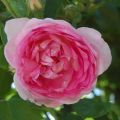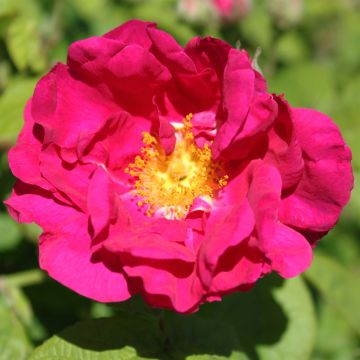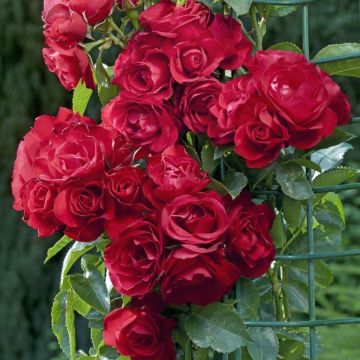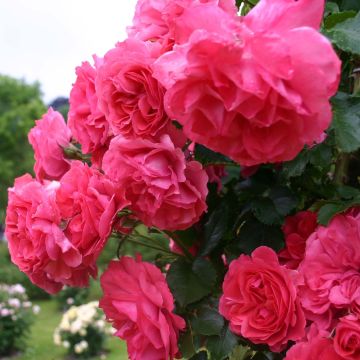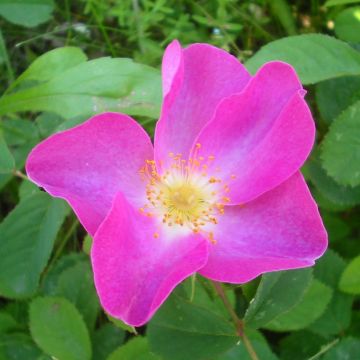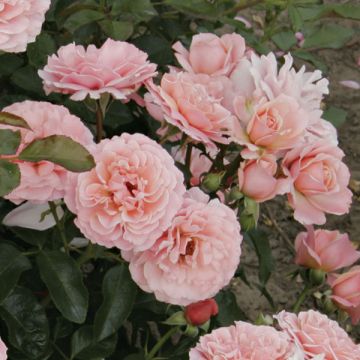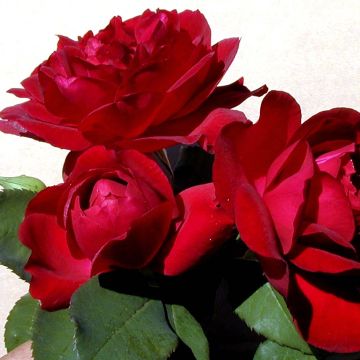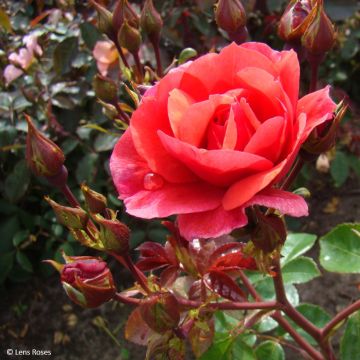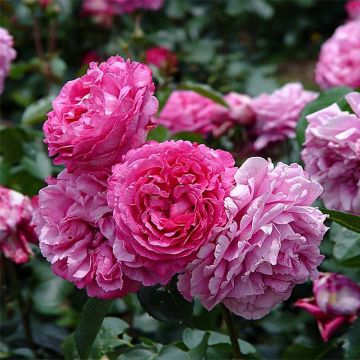

Collection of 2 Pink Climbing Roses
Collection of 2 Pink Climbing Roses
Rosa (x) grimpant Laguna® Klettermaxe ® KORadigel, Jasmina® Klettermaxe ® Korcentex
Whether it be slow growth or they have vegetated
Asta G., 17/11/2019
This item cannot be shipped to the selected country
Delivery charge from €5.90
Delivery to Corse prohibited
More information
Schedule delivery date,
and select date in basket
This plant carries a 6 months recovery warranty
More information
We guarantee the quality of our plants for a full growing cycle, and will replace at our expense any plant that fails to recover under normal climatic and planting conditions.
From €5.90 for pickup delivery and €6.90 for home delivery
Express home delivery from €8.90.
Delivery to Corse prohibited: UE law prohibits the import of this plant from mainland France to Corse as part of the fight against Xylella fastidiosa. Please accept our sincere apologies.
More information

Does this plant fit my garden?
Set up your Plantfit profile →
Collection items (2 plants)
Description
Here is a decidedly romantic duo formed of floriferous, highly fragrant and repeat-flowering climbing roses from June to October. They are adorned with double flowers that create a beautiful harmony of deep pink and soft pink with hints of purple. These two excellent varieties have also received the highly demanding A.D.R* label, guaranteeing excellent natural resistance to diseases.
The collection consists of:
- x1 Climbing Rose Jasmina: its trained stems reach a height of 3.50 m. Holder of the fragrance medal, this rose bears fully double, cup-shaped roses measuring 7 cm in diameter, formed of numerous soft pink petals with hints of purple. This beautiful Kordes creation blooms almost continuously from June until the first frosts.
- x1 Climbing Rose Laguna: a plant that often reaches 2.50 m (sometimes 3 m) from the Super Conquerant® series, a line of roses developed in Germany by Kordes that combines the floribundity of modern roses with the charm and fragrance of old roses. It stands out for the deliciously fruity fragrance of its very double, 10 cm in diameter, turbinate flowers in a carmine pink colour, which bloom in successive waves in generous clusters.
*ADR ® is the label of the German Federation of Rose Breeders. The ADR ® designation is only granted to varieties that have passed the strictest tests in the world. The plants are tested simultaneously in 10 different locations, in various soils and under different climatic conditions for several years. The tests focus on hardiness, perennial resilience, and flowering without the use of any pesticides.
Repeat-flowering climbing roses deserve a wall exposed to morning sun or a large enough structure to support their shower of flowers. They allow for magnificent displays throughout the summer period and require very little maintenance, except for regular watering in summer during periods of high heat and prolonged drought. As structural elements in English gardens, rose arches create beautiful shelters where one can rest while connecting different parts of the garden. Mix them together or combine them with easy-to-grow large-flowered clematis such as 'Etoile Violette', 'Montana Mayleen', or 'Broughton Star'. Climbing roses can also grow freely: they then form magnificent bushes that can be integrated into a flowering hedge or shrub border.
Report an error about the product description
Plant habit
Flowering
Foliage
Botanical data
Rosa
(x) grimpant
Laguna® Klettermaxe ® KORadigel, Jasmina® Klettermaxe ® Korcentex
Rosaceae
Cultivar or hybrid
Other Roses A to Z
Planting and care
Plant these roses from November to March, in well-prepared and well-drained ordinary soil. They prefer clayey, heavy rather than light soil. If the soil is too sandy, compact, or dry in summer, it is preferable to incorporate potting compost, decomposed manure, or garden compost at the bottom of the planting hole. However, these roses are averse to waterlogged soil in winter. plant them about 20 cm from their support in a sunny position, or at most in partial shade. Roses are demanding plants, and a specific fertiliser application will be beneficial at the start of the growth season, and regularly throughout the flowering period.
Planting period
Intended location
Care
-
, onOrder confirmed
Reply from on Promesse de fleurs
Haven't found what you were looking for?
Hardiness is the lowest winter temperature a plant can endure without suffering serious damage or even dying. However, hardiness is affected by location (a sheltered area, such as a patio), protection (winter cover) and soil type (hardiness is improved by well-drained soil).

Photo Sharing Terms & Conditions
In order to encourage gardeners to interact and share their experiences, Promesse de fleurs offers various media enabling content to be uploaded onto its Site - in particular via the ‘Photo sharing’ module.
The User agrees to refrain from:
- Posting any content that is illegal, prejudicial, insulting, racist, inciteful to hatred, revisionist, contrary to public decency, that infringes on privacy or on the privacy rights of third parties, in particular the publicity rights of persons and goods, intellectual property rights, or the right to privacy.
- Submitting content on behalf of a third party;
- Impersonate the identity of a third party and/or publish any personal information about a third party;
In general, the User undertakes to refrain from any unethical behaviour.
All Content (in particular text, comments, files, images, photos, videos, creative works, etc.), which may be subject to property or intellectual property rights, image or other private rights, shall remain the property of the User, subject to the limited rights granted by the terms of the licence granted by Promesse de fleurs as stated below. Users are at liberty to publish or not to publish such Content on the Site, notably via the ‘Photo Sharing’ facility, and accept that this Content shall be made public and freely accessible, notably on the Internet.
Users further acknowledge, undertake to have ,and guarantee that they hold all necessary rights and permissions to publish such material on the Site, in particular with regard to the legislation in force pertaining to any privacy, property, intellectual property, image, or contractual rights, or rights of any other nature. By publishing such Content on the Site, Users acknowledge accepting full liability as publishers of the Content within the meaning of the law, and grant Promesse de fleurs, free of charge, an inclusive, worldwide licence for the said Content for the entire duration of its publication, including all reproduction, representation, up/downloading, displaying, performing, transmission, and storage rights.
Users also grant permission for their name to be linked to the Content and accept that this link may not always be made available.
By engaging in posting material, Users consent to their Content becoming automatically accessible on the Internet, in particular on other sites and/or blogs and/or web pages of the Promesse de fleurs site, including in particular social pages and the Promesse de fleurs catalogue.
Users may secure the removal of entrusted content free of charge by issuing a simple request via our contact form.
The flowering period indicated on our website applies to countries and regions located in USDA zone 8 (France, the United Kingdom, Ireland, the Netherlands, etc.)
It will vary according to where you live:
- In zones 9 to 10 (Italy, Spain, Greece, etc.), flowering will occur about 2 to 4 weeks earlier.
- In zones 6 to 7 (Germany, Poland, Slovenia, and lower mountainous regions), flowering will be delayed by 2 to 3 weeks.
- In zone 5 (Central Europe, Scandinavia), blooming will be delayed by 3 to 5 weeks.
In temperate climates, pruning of spring-flowering shrubs (forsythia, spireas, etc.) should be done just after flowering.
Pruning of summer-flowering shrubs (Indian Lilac, Perovskia, etc.) can be done in winter or spring.
In cold regions as well as with frost-sensitive plants, avoid pruning too early when severe frosts may still occur.
The planting period indicated on our website applies to countries and regions located in USDA zone 8 (France, United Kingdom, Ireland, Netherlands).
It will vary according to where you live:
- In Mediterranean zones (Marseille, Madrid, Milan, etc.), autumn and winter are the best planting periods.
- In continental zones (Strasbourg, Munich, Vienna, etc.), delay planting by 2 to 3 weeks in spring and bring it forward by 2 to 4 weeks in autumn.
- In mountainous regions (the Alps, Pyrenees, Carpathians, etc.), it is best to plant in late spring (May-June) or late summer (August-September).
The harvesting period indicated on our website applies to countries and regions in USDA zone 8 (France, England, Ireland, the Netherlands).
In colder areas (Scandinavia, Poland, Austria...) fruit and vegetable harvests are likely to be delayed by 3-4 weeks.
In warmer areas (Italy, Spain, Greece, etc.), harvesting will probably take place earlier, depending on weather conditions.
The sowing periods indicated on our website apply to countries and regions within USDA Zone 8 (France, UK, Ireland, Netherlands).
In colder areas (Scandinavia, Poland, Austria...), delay any outdoor sowing by 3-4 weeks, or sow under glass.
In warmer climes (Italy, Spain, Greece, etc.), bring outdoor sowing forward by a few weeks.

































